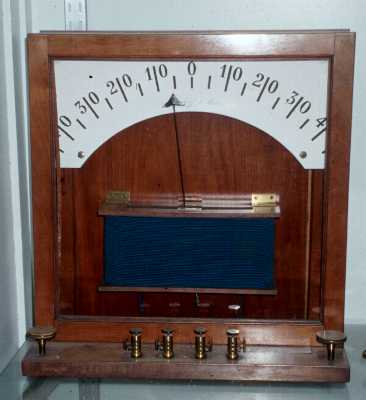On the left is the Universal Lecture Table Galvanometer made
by the L.E. Knott Apparatus C0. of Boston, and listed in their 1916 catalogue
at $35.00. This included shunts and multipliers to give the instrument potential
ranges of 5, 25 and 125 V, and current ranges of 5 and 25 amperes. The basic
meter movement, with a resistance of 1 Ohm, gave a deflection of one unit
for a current of 2 mA. This instrument is still in occasional use in the
lecture hall, primarily to show induced EMFs.
| The sheer size of this galvanometer (the glass front
measures about 41 cm on a side) and the large numerals on the scale suggest
that it was used for demonstrations in the lecture hall. The configuration
of the coil suggests that this is an iron
vane galvanometer , a rugged instrument well-adapted to the hard usage
of the lecture hall.
It is marked "Ruhmkorff à Paris" in script,
and is in the Garland Collection of Classical Physics Apparatus at Vanderbilt
University.
|

|
| The alternative to making the lecture-table meter very
large is to make it very small, and display its readings by projection. This
model, at Franklin and Marshall College in Lancaster, Pennsylvania, was made
by James W. Queen of Philadelphia. It is probably designed to slide into
a large slide projector, but the careful design of the mechanism holding
it up suggests that it might also have been used for shadow projection,
using a carbon arc as a light source.
|
| This projection galvanometer is, reasonably
enough, in the Jack Judson Collection of the Magic Lantern Museum in San
Antonio, Texas. The button on the left-hand side says that it came from the Tottenham Polytechnic in London. |
|
The lecture table galvanometer below was made by Siemens and Halske of Berlin: their logo can be seen on the scale in the left-hand image. Here the designer has taken advantage of the fact that the galvanometer pointer can be double-ended, and the lower end can be seen by the demonstrator standing behind the apparatus at the lecture bench. This galvanometer is in the Greenslade Collection in Gambier, Ohio.
|
|
|
| This lecture table galvanometer appears
in the 1909 Central Scientific Company catalogue at a cost of $15.00. Later
catalogues describe it as "Originally designed after suggestions by Prof.
R. A. Millikan, with its open construction, large size scale and large pointer,
is especially well adapted for use on the physics lecture table. The size
of the scale divisions and figures, and the size and shape of the pointer
makes it easy to read the deflections at a distance. A second scale and pointer
provided on the back aid the teaching in making classroom demonstrations.
... Thermo-electric
currents are readily detected, as the maximum deflection produced by
heating a single copper-iron junction is about 8 scale divisions. ...Sensitivity
-- A deflection of one scale division (6.1 mm) on the circular scale 8.2
cm from the axis of the coil is produced by a current of 14 microamperes." In addition to his well-known work with the measurement of the charge on the electron, Millikan wrote a physics textbook in the first years of the 20th century that spun off numerous versions for secondary and college students. His books made strong connections between the experimental and theoretical sides of physics. This instrument is in the apparatus collection of Westminster College in western Pennsylvania, and has a 1911 patent date on it,. |
The lecture table galvanometer at the right was sold by Queen of Philadelphia, and is in the collection at Case Western Reserve University on Cleveland, Ohio, |